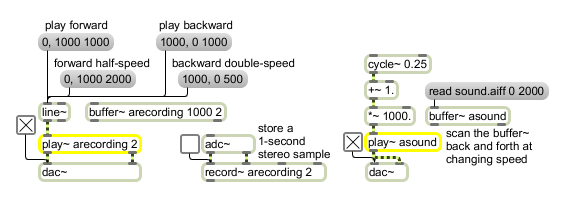Examples

play~ is usually driven by a ramp signal from line~ but other signals create novel effects
Position-based sample playback
| Name | Type | Opt | Description |
|---|---|---|---|
| buffer-object-name | symbol | Obligatory. Names the buffer~ object whose sample memory is used by play~ for playback. | |
| number-of-output-channels | int | opt | Specifies the number of output channels: 1, 2, or 4. The default number of channels is one. If the buffer~ being played has fewer channels than the number of play~ output channels, the extra channels output a zero signal. If the buffer~ has more channels, channels are mixed. |
| int | start-position [int] |
The behavior of a play~ object - it's direction and speed of playback - is set using integer messages. These messages come in pairs - an initial integer that specifies the position in the buffer (in milliseconds) at which to start, followed by a second pair of numbers that specify the ending position in the buffer and the time (in milliseconds) over which the playback will occur. These messages are often sent as messages separated by a comma. Here are some examples: - Starting at the beginning of the buffer, play 2 seconds of audio at normal speed - Play the first half second of a buffer backwards at normal speed. - Play the first second of a buffer at double speed (i.e. transpose it up an octave) |
| (mouse) | Double-clicking on buffer~ opens a display window where you can view the contents of the buffer~. object that the play~ object references. | |
| set | buffer-object-name [symbol] |
The word , followed by the name of a buffer~ object, uses that buffer~ for playback. |
| signal | In left inlet: The position (in milliseconds) into the sample memory of a buffer~ object from which to play. If the signal is increasing over time, play~ will play the sample forward. If it is decreasing, play~ will play the sample backward. If it remains the same, play~ outputs the same sample repeatedly, which is equivalent to a DC offset of the sample value. |
